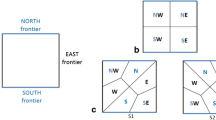Abstract
This paper presents a computational method for converting a non-conformal hex-dominant mesh to a conformal hex-dominant mesh without help of pyramid elements. During the conversion, the proposed method subdivides a non-conformal element by applying a subdivision template and conformal elements by a conventional subdivision scheme. Although many finite element solvers accept mixed elements, some of them require a mesh to be conformal without a pyramid element. None of the published automated methods could create a conformal hex-dominant mesh without help of pyramid elements, and therefore the applicability of the hex-dominant mesh has been significantly limited. The proposed method takes a non-conformal hex-dominant mesh as an input and converts it to a conformal hex-dominant mesh that consists only of hex, tet, and prism elements. No pyramid element will be introduced. The conversion thus considerably increases the applicability of the hex-dominant mesh in many finite element solvers.





























Similar content being viewed by others
References
George PL (1999) Tet meshing: construction, optimization and adaptation. In: Proceedings of 8th international meshing roundtable, pp 133–141
Yamakawa S, Shimada K (2003) Anisotropic tetrahedral meshing via bubble packing and advancing front. Inter J Numer Methods Eng 57:1923–1942
Shewchuk J (2002) Constrained delaunay tetrahedralizations and provably good boundary recovery. In: Proceedings of 11th international meshing roundtable, pp 193–204
Blacker TD, Meyers RJ (1993) Seams and wedges in plastering: a 3-D hexahedral mesh generation algorithm. Eng Comput 2:83–93
Schneiders R (1996) A grid-based algorithm for the generation of hexahedral element meshes. Eng Comput 12:168–177
Tautges TJ, Blacker T, Mitchell SA (1996) The whisker weaving algorithm: a connectivity-based method for constructing all-hexahedral finite element meshes. Inter J Numer Methods Eng 39:3327–3349
Ledoux F, Weill J-C (2007) An extension of the reliable whisker weaving algorithm. In: Proceedings of 16th international meshing roundtable, pp 215–232
Staten ML, Owen SJ, Blacker TD (2005) Unconstrained paving and plastering: a new idea for all hexahedral mesh generation, In: Proceedings of 14th international meshing roundtable, pp 399–416
Taghavi R (2000) Automatic block decomposition using fuzzy logic analysis. In: Proceedings of 9th international meeting roundtable, pp 187–192
Kwak D-Y, Im Y-T (2002) Remeshing for metal forming simulations-Part II: three-dimensional hexahedral mesh generation. Inter J Numer Methods Eng 53:2501–2528
Hariya M, Nishigaki I, Kataoka I, Hiro Y (2006) Automatic hexahedral mesh generation with feature line extraction. In: Proceedings of 15th international meshing roundtable, pp 453–467
Maréhal L (2001) A new approach to octree-based hexahedral meshing. In: Proceedings of 10th international meshing roundtable, pp 209–221
Yamakawa S, Shimada K (2002) HEXHOOP: modular templates for converting a hex-dominant mesh to an all-hex Mesh. Eng Comput. 18:211–228
Mitchell SA (1998) The all-hex geode-template for conforming a diced tetrahedral mesh to any diced hexahedral mesh. In: Proceedings of 7th international meshing roundtable, pp 29–305
White DR, Tautges TJ (2000) Automatic scheme selection for toolkit hex meshing. Intern J Numer Methods Eng 49:127–144
Lai M, Benzley S, White D (2000) Automated hexahedral mesh generation by generalized multiple source to multiple target sweeping. Inter J Numeri Methods Eng 49:261–275
Shepherd J, Mitchell SA, Knupp P, White D (2000) Methods for multisweep automation. In: Proceedings of 9th international meshing roundtable, pp 77–87
Quadros WR, Shimada K (2002) Hex-layer: layered all-hex mesh generation on thin section solids via chordal surface transformation. In: Proceedings of 11th international meshing roundtable, pp 169–180
Meshkat S, Talmor D (2000) Generating a mixed mesh of hexahedra, pentahedra and tetrahedra from an underlying tetrahedral mesh. Inter J Numer Methods Eng 49:17–30
Meyers RJ, Tautges TJ, Tuchinsky PM (1998) The “Hex-tet” hex-dominant meshing algorithm as implemented in CUBIT. In: Proceedings of 7th international meshing roundtable, pp 151–58
Owen SJ, Saigal S (2000) H-Morph: an indirect approach to advancing front hex meshing. Inter J Numer Methods in Eng 49:289–312
Yamakawa S, Shimada K (2003) Fully-automated hex-dominant mesh generation with directionality control via packing rectangular solid cells. Int J Numer Methods Eng 57:2099–2129
Becker EB, Carey GF, Oden JT (1981) Finite elements: an introduction, vol. 1. Prentice Hall, NJ
Knupp PM (2000) Achieving finite element mesh quality via optimization of the Jacobian matrix norm and associated Quantities. Part II —A framework for volume mesh optimization and the condition number of the jacobian matrix. Int J Numer Methods Eng 48:1165–1185
Freitag LA, Plassmann PE (2001) Local optimization-based untangling algorithms for quadrilateral meshes. In: Proceedings of 10th international meshing roundtable, pp 397–406
Zhou T, Shimada K (2000) An angle-based approach to two-dimensional mesh smoothing. In: Proceedings of 9th international meshing roundtable, pp 373–384
Calvo NA, Idelsohn SR (2001) All-hexahedral mesh smoothing with a node-based measure of quality. Int J Numer Methods Eng 50:1957–1967
Klingner BM, Shewchuck JR (2007) Aggressive tetrahedral mesh improvement. In: Proceedings of 16th international meshing roundtable, pp 3–23
Joe B (1995) Construction of three-dimensional improved-quality triangulations using local transformations. SIAM J Sci Comput 16:1292–1307
Molinari JF, Ortiz M (2002) Three-dimensional adaptive meshing by subdivision and edge-collapse in finite-deformation dynamic-plasticity problems with application to adiabatic shear banding. Int J Numer Methods Eng 53:1101–1126
Yamakawa S, Shimada K (2008) Converting a tetrahedral mesh to a prism-tetrahedral hybrid mesh for FEM accuracy and efficiency. In: Proceedings of ACM symposium on solid and physical modeling, pp 287–294
Abaqus, Dassault Systemes. http://www.simulia.com
Author information
Authors and Affiliations
Corresponding author
Rights and permissions
About this article
Cite this article
Yamakawa, S., Gentilini, I. & Shimada, K. Subdivision templates for converting a non-conformal hex-dominant mesh to a conformal hex-dominant mesh without pyramid elements. Engineering with Computers 27, 51–65 (2011). https://doi.org/10.1007/s00366-010-0178-6
Received:
Accepted:
Published:
Issue Date:
DOI: https://doi.org/10.1007/s00366-010-0178-6




